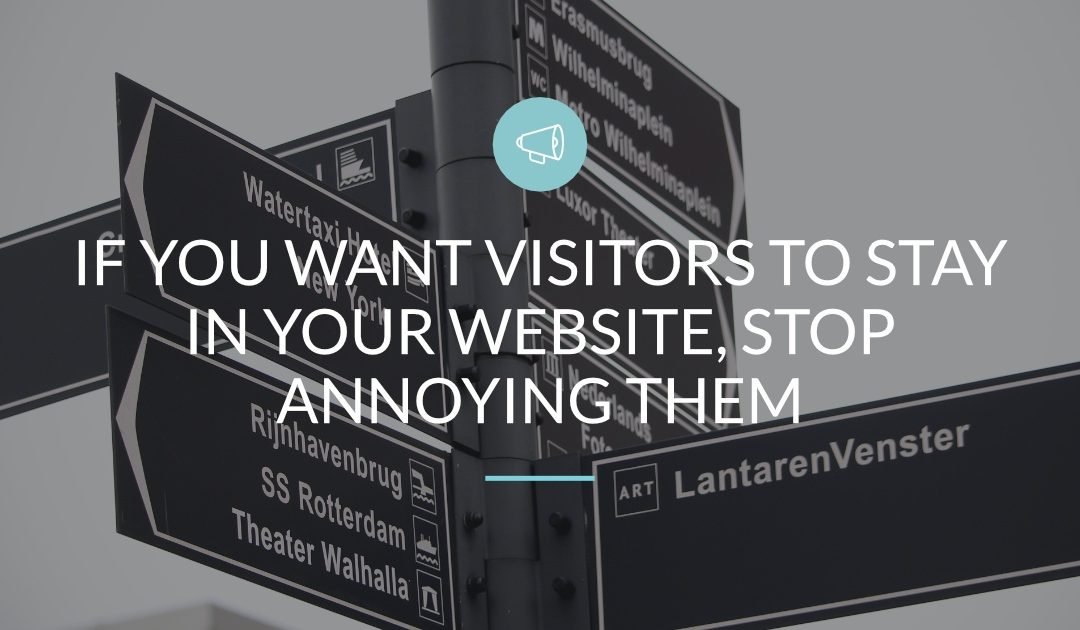If you want visitors to stay on your website, STOP annoying them
If you have a website for your business, odds are you love it. Then again, odds are you love your dog, even though he growls at the mailman and keeps the neighbors awake barking at 3 in the morning. Spoiler alert: the mailman and your neighbors don’t love your dog. And there’s a reasonably good chance your customers and prospective customers don’t love your website.
You Want Website Visitors!
Have you ever been on a website, in the middle of an article, and a pop-up takes over, usually something you have no interest in? You have to wait for that pop-up to fully load so you can hit the “X” or “no thanks” button as quickly as possible and get back to your article. Did that make you love that business, or did it make you roll your eyes? How about a website that takes an eternity to load—ever say, “OK, enough is enough” and hit the road?
The truth is, most websites have features that annoy a lot of the people who go there, and that can’t be good for your business. So, it makes sense to nix those annoying features and give people a user experience they feel good about—that way, they’re more likely to buy your products and services.

1. It takes too long to load:
you might think it doesn’t make much difference that your site takes 4 or 5 seconds to load, but it does. According to KISSmetrics, 47% of site visitors expect a website to load in 2 seconds or less—and 40% will abandon a site that takes more than 3 seconds to load. And the longer your site takes to load, the more people will blame you and not their internet service provider. Think about it: if your site takes 4 seconds to load, you’re losing 40% of potential customers, and that’s a big deal. Test your site to see how long it takes to load—if it’s slow, fix the problem.
2. The About Us page is about…nothing:
when people go to your website, they want to know what you do, period. Now, they probably went there after clicking on organic search results, or maybe a PPC ad, but you still need to tell them, in clear and simple language, that they’re in the right place. Still, there’s a slew of websites, including those of some Fortune 500 companies, who get too cute by half telling you they’re really good at whatever it is they do, or that they really care about their customers when they sell them whatever it is they sell. Stop annoying site visitors by making them guess—tell them in clear, everyday language they can easily understand that what you do is sell refrigerators, or kayaks, or CRM software.
3. It’s not optimized for mobile:
in November 2016, it became official—for the first time there were more mobile searches than searches on desktop computers. That means it’s likely at least half of the visitors to your website are looking at the mobile version. Have you ever been on a mobile site that’s not responsive? Remember straining your eyes to read the copy, or typing tiny letters into a tiny search box? Do you really want to put your customers through that? And there’s another reason to go mobile-friendly: Google is now rolling out it’s mobile-first indexing, which means you’ll now get ranked in search results based on the quality of your mobile site (if you have one). Why take the risk of annoying both Google and your customers? If you’re not optimized for mobile, get optimized asap.
4. There’s a “contact us” form, but you don’t contact them:
first, you should never use a “contact us” form as a way to generate leads—there are plenty of better, less deceptive ways of doing that. People who fill in your form are not telling you they want to be added to your email list. Typically, they have a one-time problem they want you to fix. Second, your contact us form contains an implicit promise—that you’ll get back to someone, and soon, if they take the time to fill it out. If you don’t, or if it takes days or weeks for someone to get a response, well, that’s annoying. Either remove the form or make a commitment to reply to people’s queries in a timely manner.
5. Those annoying pop-ups:
pop-ups are OK, but in moderation, and when used in a way that doesn’t try to guilt your site visitors. Do you really want to ask visitors to your site—people in whom you’re trying to instill trust in your business—to click on a box that says, “No thanks, I don’t want to improve my website”? Well, they don’t mean it; of course, they want to improve their website—they just don’t want to download whatever you’re asking them to download right now—because they’re right in the middle of something else! So, in essence, the choice you’re giving them is either to lie or to view content they don’t want to view—and that’s annoying. Make sure you use pop-ups sparingly, and always respectfully.
My final thoughts…
A great website is one that effectively communicates your brand, pushes stellar content, features outstanding navigation and puts your products and services in the best possible light. It’s also about good old fashioned common sense. Sometimes it’s a good idea to walk in your customers’ shoes—go to your website as if you were a customer. What inspires and delights you, and what makes you want to run for the exit door? Better yet, ask someone who knows how to design great websites to take a look at yours.
To learn more about the ways our SEO, social media, web design, web audit, and PPC services can help you boost sales and grow your business, contact us today.
Book Your Free Consultation Today

Founder & CEO of ThinkFlame, Shelly Patrick, trains individuals and companies to understand how their marketing affects their sales conversation and how to integrate marketing into their yearly plans for consistent growth.

